Topics
Category
Era
Johnson, Nellie Stone (1905–2002)
Nellie Stone Johnson was an African American union and civil rights leader whose career spanned the class-conscious politics of the 1930s and the liberal reforms of the Minnesota DFL Party. She believed unions and education were paths to economic security for African Americans, including women. Her self-reliant personality and pragmatic politics sustained her long and active life.
Born in 1905 to Dakota County farmers who stressed religious and racial tolerance, Johnson absorbed lessons about organizing at a young age. Her father was a Nonpartisan League member who rallied Pine County farmers to join cooperatives and elect insurgent candidates to office. Milk and potato prices, Johnson learned, were set in far-off Minneapolis. The dairy and electric cooperatives her father promoted helped increase farm income.
After moving to Minneapolis to finish high school, Johnson was hired as an elevator operator by the Minneapolis Athletic Club in 1924. There, and at the West Hotel, she experienced workplace discrimination and faced anti-union employers. She believed the worst discrimination was economic, but trusted that organizing and collective bargaining could improve a worker’s lot.
Johnson met communists, radicals, and the itinerant socialist union organizer Swan Assarson in the 1920s while taking classes at the University of Minnesota. A radical himself who believed in a workers’ society, Assarson mentored Johnson in organizing hotel workers. Johnson’s father also encouraged her activism. Together, they delivered potatoes and rutabagas off his Pine County farm to worker kitchens during the 1934 Teamsters strike.
Minneapolis hotels and restaurants were not organized when the National Labor Relations Act emboldened workers to take action in 1935. The New Deal law changed the landscape in workplaces by protecting organizing and collective bargaining activities. It also motivated Johnson and African American leaders Anthony Cassius and Albert Allen Jr. to talk to union members and educate their co-workers in the city’s downtown hotels.
Cassius led the Curtis Hotel workforce into Local #614 of the Hotel and Restaurant Workers Union. His leadership sparked organizing at other hotel worksites. Allen championed efforts at the Athletic Club, where Johnson and white co-worker George Naumoff soon organized all the shifts. Local #665 of the Hotel Employees Union was quickly chartered at the Athletic Club as an integrated union.
Johnson was one of the first women to sit on her local’s contract-negotiating committee. Gradually, things began to change in the hotel industry. Wage increases and uniform job classifications ended racial and gender pay inequities. At the Athletic Club, Johnson pushed to end in-house segregation of eating and locker room facilities.
Johnson’s prominence in union circles widened. She was elected vice president of her local union in 1936 and sat on the important statewide hotel and restaurant workers’ council. She worked with progressive trade unionists at the Minneapolis Central Labor Union and urged hotel unions to affiliate with the Minnesota AFL. At times, she challenged more conservative AFL union officials to organize the unorganized.
Minneapolis unions supported the Farmer-Labor Party in the 1930s and 1940s. Johnson became deeply involved in the Farmer-Labor Association, the party’s educational arm. At the same time, she was a member of the powerful union-based United Labor Committee, which endorsed candidates. In these roles, she discovered her talent for planning and executing political campaigns.
Organized labor shared the goals of full employment, health insurance, and affordable housing with liberal politicians like Hubert Humphrey, whom Johnson met in about 1938. Humphrey was impressed with her labor and civil rights activism and sought her support when he ran for mayor of Minneapolis in 1943 and again in 1945.
Throughout her career, Johnson remained pragmatic. When the Farmer-Labor Party’s influence waned in the 1940s, she helped create a merged Democratic and FL Party and swung her allegiance to what she believed would be a multi-racial, labor-oriented DFL.
Johnson remained active in labor and DFL politics as the civil rights movement gained momentum in Minneapolis and across the United States. She helped forge the city’s first Fair Employment Commission, successfully ran for the Library Board, and spearheaded passage of the Minnesota’s Fair Employment and Fair Housing Laws (1955 and 1957). In 1972, she campaigned for Van White, the first African American elected to the City Council.
Johnson died in Minneapolis, in 2002, at the age of ninety-six.
Bibliography
Delton, Jennifer. “Labor, Politics and African American Identity in Minneapolis, 1930–1950.” Minnesota History 57, no. 8 (Winter 2001–2002): 418–434.
http://collections.mnhs.org/MNHistoryMagazine/articles/57/v57i08p418-434.pdf
Johnson, Nellie Stone. Nellie Stone Johnson: The Life of An Activist; as Told to David Brauer. St. Paul: Ruminator Books, 2000.
OH30
Oral History interviews of the 20th Century Radicalism in Minnesota Oral History Project, 1972–1989
Oral History Collection, Minnesota Historical Society, St. Paul
http://collections.mnhs.org/voicesofmn/index.php/10002528
Description: These seventy interviews document the role of left-wing radicalism is shaping Minnesota’s political culture.
Related Resources
Primary
P939 Johnson, Nellie Stone
Biographical Data on Nellie Stone Johnson, undated, 1949, 1995–1997
Manuscript Collection, Minnesota Historical Society, St. Paul
Description: Biographical materials on Nellie Stone Johnson.
Secondary
Bauerlein, Monica. “Nellie Stone Johnson: 1905–2002. Minneapolis Loses a Legendary Figure.” City Pages, April 10, 2002.
Delton, Jennifer. Making Minnesota Liberal: Civil Rights and the Transformation of the Democratic Party. Minneapolis: University of Minnesota Press, 2002.
“History Theatre Opens Nellie Stone Johnson Play.” Minneapolis Star Tribune, January 23, 2013.
Kucera, Barb. “Nellie Stone Johnson: Trailblazer in Politics, Labor and Civil Rights.” Workday Minnesota, March 4, 2007.
“Black History in Minnesota Examined.” MPR News, February 7, 2013.
http://www.mprnews.org/story/2013/02/08/mpr_news_presents
Nellie Stone Johnson. VHS. Osseo, MN: Independent School District 279, 1983.
Pruitt, Mary Christine. “‘Women Unite!’: The Modern Women’s Movement in Minnesota.” PhD Thesis, University of Minnesota, 1987.
Roberts, Norene. “Minding Her Business.” Roots 9, no.2 (Winter 1981): 24–27.
Rosenblum, Gail. “Rosenblum: Capitol Would Gain With Statue of Nellie Stone Johnson.” Minneapolis Star Tribune, May 5, 2015.
Wingerd, Mary Lethert. Claiming the City: Politics, Faith and the Power of Place in St. Paul. Ithaca, NY: Cornell University Press, 2001.
Web
Blackpast.org. Johnson, Nellie Stone (1905–2002).
http://www.blackpast.org/aah/johnson-nellie-stone-1905-2002
Related Video
Women in Minneapolis History: Nellie Stone Johnson
More Information
Articles
Related Images
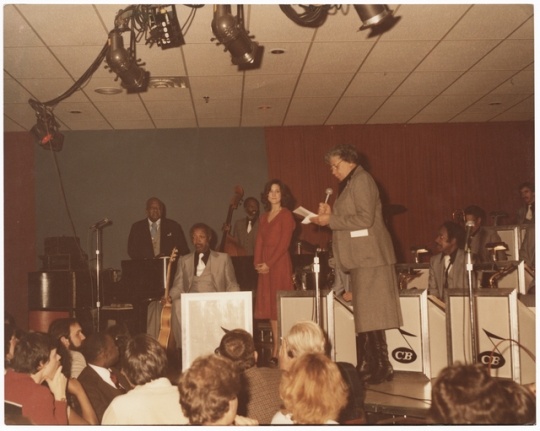
Nellie Stone Johnson with the Count Basie Orchestra
Holding Location
Articles
More Information
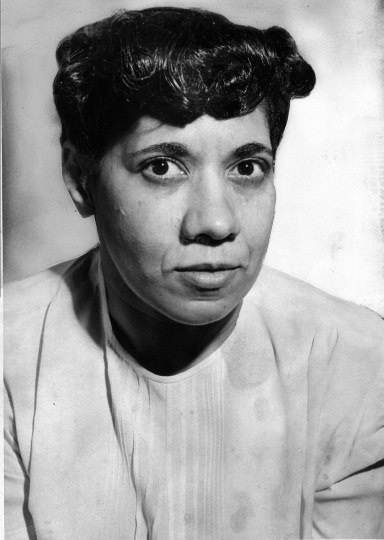
Nellie Stone Johnson
Holding Location
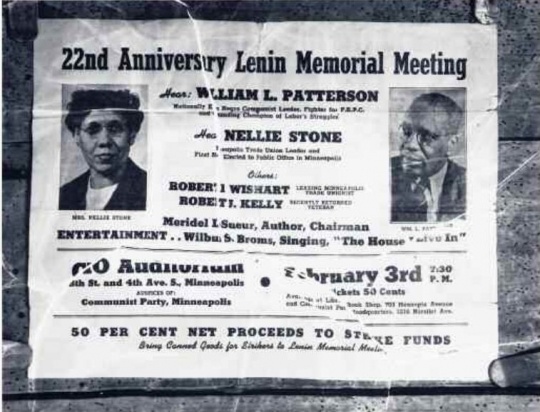
Lenin Memorial Meeting flyer
Holding Location
Articles
More Information
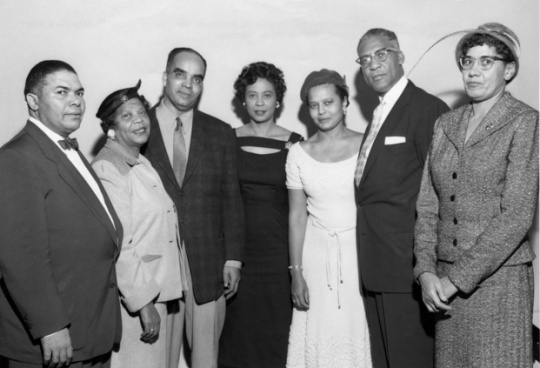
Nellie Stone Johnson with NAACP leaders
Nellie Stone Johnson (far right) with NAACP leaders, including Anthony Cassius (far left); publisher Milton G. Williams (third from left); and Howard Bennett, later appointed Minnesota’s first black judge (second from right), 1954.
Holding Location
Articles
More Information
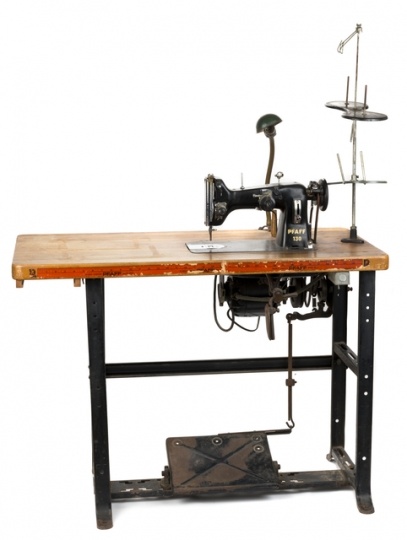
Sewing machine used by Nellie Stone Johnson
Articles
More Information

Nellie Stone Johnson at Nellie's Shirt and Zipper repair shop
Holding Location
Articles
More Information

Nellie Stone Johnson with the Count Basie Orchestra
Holding Location
Articles
More Information

Nellie Stone Johnson
Holding Location

Lenin Memorial Meeting flyer
Holding Location
Articles
More Information

Nellie Stone Johnson with NAACP leaders
Nellie Stone Johnson (far right) with NAACP leaders, including Anthony Cassius (far left); publisher Milton G. Williams (third from left); and Howard Bennett, later appointed Minnesota’s first black judge (second from right), 1954.
Holding Location
Articles
More Information

Sewing machine used by Nellie Stone Johnson
Articles
More Information

Nellie Stone Johnson at Nellie's Shirt and Zipper repair shop
Holding Location
Articles
More Information

Nellie Stone Johnson with the Count Basie Orchestra
Holding Location
Articles
More Information
Related Articles
Turning Point
Johnson meets socialist Swan Assarson around 1929. He mentors her in practical organizing and principled politics.
Chronology
1905
1918
1922
1925
1931
1934
1936
1944
1945
1947
1963
1979
1980
1987
2002
Bibliography
Delton, Jennifer. “Labor, Politics and African American Identity in Minneapolis, 1930–1950.” Minnesota History 57, no. 8 (Winter 2001–2002): 418–434.
http://collections.mnhs.org/MNHistoryMagazine/articles/57/v57i08p418-434.pdf
Johnson, Nellie Stone. Nellie Stone Johnson: The Life of An Activist; as Told to David Brauer. St. Paul: Ruminator Books, 2000.
OH30
Oral History interviews of the 20th Century Radicalism in Minnesota Oral History Project, 1972–1989
Oral History Collection, Minnesota Historical Society, St. Paul
http://collections.mnhs.org/voicesofmn/index.php/10002528
Description: These seventy interviews document the role of left-wing radicalism is shaping Minnesota’s political culture.
Related Resources
Primary
P939 Johnson, Nellie Stone
Biographical Data on Nellie Stone Johnson, undated, 1949, 1995–1997
Manuscript Collection, Minnesota Historical Society, St. Paul
Description: Biographical materials on Nellie Stone Johnson.
Secondary
Bauerlein, Monica. “Nellie Stone Johnson: 1905–2002. Minneapolis Loses a Legendary Figure.” City Pages, April 10, 2002.
Delton, Jennifer. Making Minnesota Liberal: Civil Rights and the Transformation of the Democratic Party. Minneapolis: University of Minnesota Press, 2002.
“History Theatre Opens Nellie Stone Johnson Play.” Minneapolis Star Tribune, January 23, 2013.
Kucera, Barb. “Nellie Stone Johnson: Trailblazer in Politics, Labor and Civil Rights.” Workday Minnesota, March 4, 2007.
“Black History in Minnesota Examined.” MPR News, February 7, 2013.
http://www.mprnews.org/story/2013/02/08/mpr_news_presents
Nellie Stone Johnson. VHS. Osseo, MN: Independent School District 279, 1983.
Pruitt, Mary Christine. “‘Women Unite!’: The Modern Women’s Movement in Minnesota.” PhD Thesis, University of Minnesota, 1987.
Roberts, Norene. “Minding Her Business.” Roots 9, no.2 (Winter 1981): 24–27.
Rosenblum, Gail. “Rosenblum: Capitol Would Gain With Statue of Nellie Stone Johnson.” Minneapolis Star Tribune, May 5, 2015.
Wingerd, Mary Lethert. Claiming the City: Politics, Faith and the Power of Place in St. Paul. Ithaca, NY: Cornell University Press, 2001.
Web
Blackpast.org. Johnson, Nellie Stone (1905–2002).
http://www.blackpast.org/aah/johnson-nellie-stone-1905-2002








